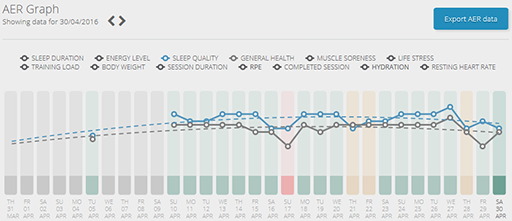6 Insight: surveillance or support?
The loss of valuable training preparation time through overtraining, injury or worse can be prevented via effective monitoring. In preparation for the 2016 Rio Olympics, the English Institute of Sport developed an app as part of their Personal Data Management System (PDMS).
This app collected an athlete’s personal data, thirteen dimensions of which are shown in Figure 4. For example, you can see how training load, health, recovery, sleep, hydration and life stress are all included in one dashboard. Quantitative and qualitative information is collected on an athlete’s ‘Availability’ to train, the ‘Effort’ they were able to exert and how they feel afterwards during ‘Recovery’. This is an attempt to assemble a range of valuable information in one place so coach and other support staff can accurately monitor an athlete’s well-being.
Note: RPE = Rate of Perceived Exertion
Activity 5 Athlete load and recovery monitoring
Watch the video below and answer the following:
- List three reasons why it is claimed this app may help with prevention of overtraining.
- How much does this app rely on athletes engaging with its ethos? Or, is it a means of the organisation exerting undue surveillance and pressure?
Transcript: Video 3
Discussion
- These are the three reasons that you may have identified, although you might express them differently or have identified another. First, the app helps in identifying training patterns over time including indicating possible problems associated with overtraining, before they escalate. Second, it is claimed the information allows training to be adapted to individual needs, including fatigue and mood, each day. Third, it perhaps allows strength and conditioning coaches to work with medical and other support staff more holistically and arguably to be more effective.
- Certainly, the app will only really work if all athletes are honest and complete it regularly. However, for some it might be regarded as too much intrusion and control into their lives and may be perceived as increased pressure. As a thought experiment, you might consider whether this tool would have prevented the ‘going under the radar’ behaviour of Clay (athletics) in Activity 3.
The very app that you have seen in action at the EIS recently came under discussion during a BBC radio programme. This is the focus of the following section.

